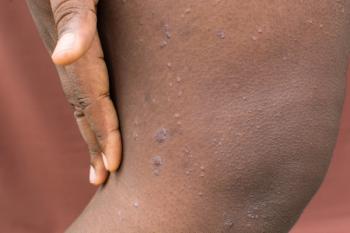
Vitamin D Analogues Combined With Topical Corticosteroids Successfully Treats Vitiligo
Patients with vitiligo can increase repigmentation through vitamin D and topical corticosteroid therapy.
Combining topical corticosteroids with vitamin D analogues resulted in greater efficacy rates and mitigate harsh effects associated with corticosteroids in vitiligo treatment,
The main purpose of the systematic review was to analyze the utilization of topical vitamin D when treating vitiligo, an autoimmune pigmentary disorder characterized by loss of functional melanocytes in the epidermis and the infundibulum of the hair. Topical corticosteroids and calcineurin inhibitors are typically the first form of treatment therapy for patients with vitiligo. However, research over the years has shown vitamin D3 accelerates the repigmentation process by increasing levels of tyrosinase activity and melanogenesis.
Effectiveness of 2 main topical vitamin D treatments, calcipotriol and tacalcitol, was evaluated in patients with vitiligo under a systematic review of comprehensive scholarly sources. PubMed and Scopus were database sources involved in retrieving research conducted between 2003 and 2023.
Inclusion and exclusion data were calculated using the total number of journal articles in Scopus (n= 327) and PubMed (n = 188) involving vitiligo treatment. Results included articles, books, book chapters, clinical trials, and randomized control trials.
After reviewing data extractions based on relevance, a total of 27 studies were selected as research materials with (n = 1198) as the findings. According to the study data, the topical vitamin D analogue, calcipotriol, made up 70% of vitiligo management. Topical formulas were mainly ointments (77.5%), but cream (18.5%) and solutions (4%) were represented as well. Research on tacalcitol (22%) and cholecalciferol (8%) had significantly lower evidence.
Study success was divided into an excellent response, good response, moderate response, and a poor response, represented by26%, 40%, 18%, and 26% of cases, respectively. Combined treatments in calcipotriol related studies included Psoralens Long Wave Ultraviolet Radiation (PUVA) or Narrowband Ultraviolet Phototherapy (NB-UVB). In cases where calcipotriol and PUVA treat vitiligo, 53.3% reported a good response, with combination groups reaching 69% poor to moderate repigmentation. When NB-UVB treated vitiligo, the outcome was successful but adding calcipotriol did not contribute to any major differences.
Another common form of treatment for vitiligo is Monochromatic Excimer Light (MEL). Research found the combination of MEL with calcipotriol ointment did not result in further efficacy improvements. A study applying either calcipotriol or clobetasol as a monotherapy did not experience significant differences after MEL treatment either. The minor repigmentation in lesions treated with calcipotriol was 85% while clobetasol treated 77% of lesions.
Successful cases of consistent repigmentation were present in combination therapy of betamethasone (BM) and calcipotriol ointment. In comparison to calcipotriol repigmentation (60.67%) and NB-UVB monotherapy (46.67%), the combination of calcipotriol and BM resulted in a 63.33% repigmentation rate. Topical steroids, like BM, proved effectiveness in successful repigmentation while managing any adverse effects in vitiligo lesion treatment.
NB-UVB phototherapy was classified as the most effective and safe form of treatment for patients with vitiligo in comparison to calcipotriol and tacrolimus (40%, 10%, and 30%, respectively). Vitiligo lesions have improved through calcipotriol ointment as a monotherapy and adding tacrolimus and/or NB-UVB phototherapy has proven further positive outcomes.
When NB-UVB combines with tacalcitol, it is likely more effective than combining with calcipotriol. Since evidence points to NB-UVB phototherapy as a functional treatment in vitiligo for repigmentation, combining it with tacalcitol enhanced the effectiveness and sped up skin repigmentation. In contrast, tacalcitol expressed little to no effects of skin repigmentation when combined with MEL.
Vitamin D3 ointment and PUVA phototherapy achieved more than 30% of moderate improvement rates in 48% of patients. Another study found the combination of topical vitamin D3 and microneedling as a productive treatment for stable vitiligo.
Topical corticosteroids with vitamin D analogues, such as calcipotriol and tacalcitol, could potentially enhance therapeutic outcomes for vitiligo in conjunction with NB-UVB phototherapy. A greater efficacy rate is achieved when using combination therapy methods rather than relying on one form of treatment. The study authors noted, “Further studies are necessary to investigate the specific protocols, dosages, and treatment durations to maximize the therapeutic benefits of vitamin D analogues in the management of vitiligo.”
Reference
Al-Smadi K, Ali M, Alavi SE, et al. Using a topical formulation of vitamin d for the treatment of vitiligo: A systematic review. Cells. 2023; 12(19):2387.
Newsletter
Stay ahead of policy, cost, and value—subscribe to AJMC for expert insights at the intersection of clinical care and health economics.







































